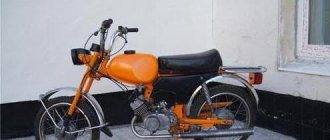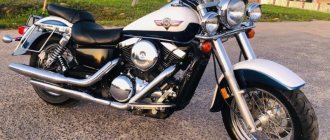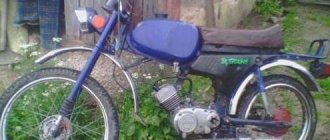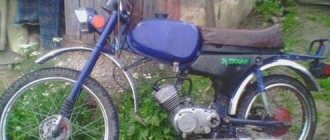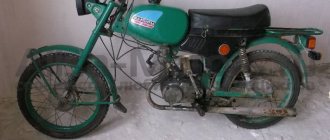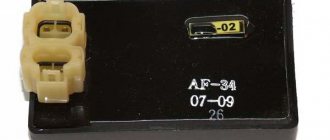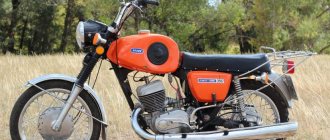Moped or mokick?
By default, we call small-capacity two-wheeled vehicles mopeds.
Some distinguish a separate group - scooters. But a moped is a vehicle with pedals and driven by them. A Mokik is a vehicle equipped with a kick starter, hence the name. Nowadays, there are no classic mopeds on sale, there are only bicycles with outboard motors.
The design has something in common with Izh Planet Sport. Photo: Youtube.com
In the USSR, pedal models were not respected, but mokicks were considered “cool”. Although, in the cities, any moped, and even a bicycle with an engine, was the subject of envy.
But within the framework of this article we will call the Carpathians differently, because that is what is customary.
The smallest moped in the USSR, which was assembled in Riga - Riga-26
Such technology, which was developed by engineers during the Soviet Union, cannot be found today. At that time, everyone was trying to create something more perfect, and some garage craftsmen assembled one big one from several types of transport.
Today, every manufacturer uses modular platforms that allow them to develop different types of equipment. Even the simplest moped can be equipped with all the amenities for a comfortable ride. In those days, even this type of transport had to be worked on for a long time. For example, after a night ride on a motorcycle, it then needed to be repaired for more than one day. Of course, there was good equipment that performed well in operation, but not all drivers could afford it. The bulk of the population traveled on mass-produced motorcycles. Another transport that was popular in the USSR was the moped. At that time, there were not many enterprises on the territory of the Soviet Union that were engaged in the production of such equipment, and accordingly, the products themselves were in short supply on the market.
However, there was one brand whose products simply flooded the market - Riga. They were assembled in the city of the same name, and almost all teenagers in the country rode such mopeds. The most interesting model in the manufacturer’s lineup is the Riga 26 Mini. It was released in 1984 and immediately gained great popularity. It reached a height of only 52 centimeters if the steering wheel was folded. The weight of the moped was comparable to a sack of potatoes - it did not exceed 50 kg. But the load capacity was decent - up to 100 kg. This device was driven by a motor with a volume of 49.8 cubic meters and a power of 1.8 hp. Fuel consumption was about 2 liters per 100 km, while the tank capacity was 5.5 liters. Such a vehicle was powered by a whole mixture, which consisted of A-72 or A-76 gasoline with oil. The engine had a K-60 carburetor and electric ignition.
In fact, it can be given the name “mokick”, since the engine was started using a kick starter. The moped could carry one passenger and a load of up to 15 kg. Note that he could drive on roads with different surfaces. To make transportation and storage even easier, the manufacturer created a folding mechanism - the steering wheel moved and the seat lowered. As a result, the mini-moped turned into an even smaller vehicle. Its height was 52 cm and width - 35 cm. It easily fit into the trunk of a regular GAZ-24, or Volga in common parlance.
The moped had a multi-disc clutch. The manual transmission was designed for 2 speeds. The driver switched gears using a handle located on the steering wheel. On the road, Riga-26 could reach up to 40 km/h. The peculiarity of the mokik is its small wheels measuring 3.00-10. The disks are made of two stamped halves and fastened with bolts. The manufacturer produced a more expensive model Riga-26 “Lux”. It differed from the standard one by having a trunk in the front and a basket in the rear. Note that Riga-26 then cost 250 rubles. It can still be found on sale today with a price tag of 15,000 - 20,000 rubles.
In 1985, the company decided to reach a new level and improve the model. The creation of Riga-30 began at the Riga plant. It featured a spring rear suspension, gears were switched using pedals, and the muffler was slightly raised up.
Bottom line . The most interesting developments in the automotive industry occurred during the Soviet Union. For example, the Riga-26 mini-moped was very popular in the 80s, although it was not distinguished by its large dimensions and high power.
The first model and its varieties
Mokic debuted in 1981.
Karpaty became the most popular and large-scale moped in the entire history of the Lviv Motor Plant. It was assembled until 1986, then a new model appeared on the assembly line - Karpaty-2. Over the years of production, the moped had different indices. They were assigned after modifications and upgrades, usually after replacing the engine. The engines installed in the Carpathians differed from each other, but their performance characteristics remained approximately at the same level. The working volume never exceeded 50 cm3, power - no more than 1.8 liters. With.
The basic modification was called LMZ-2.160.
The Leningrad branch of the Institute of Technical Aesthetics helped the Lvov Motorcycle Plant develop Karpaty-1 Sport. It received the factory index LMZ-2.160C.
Carpathians-1 Sports. Photo: Youtube.com
Externally, the moped looked sporty, although in the 80s this term was understood as motocross.
Differences between Karpaty-1 Sport and the base model:

